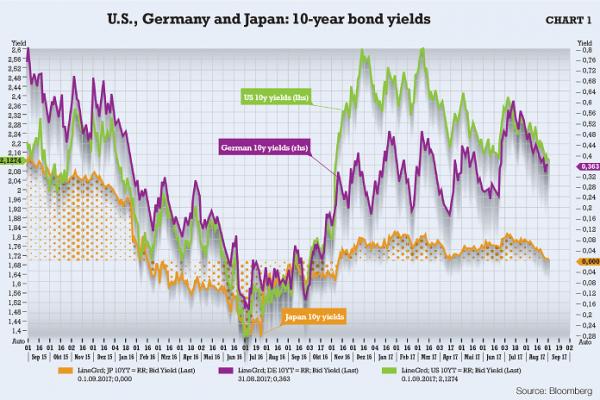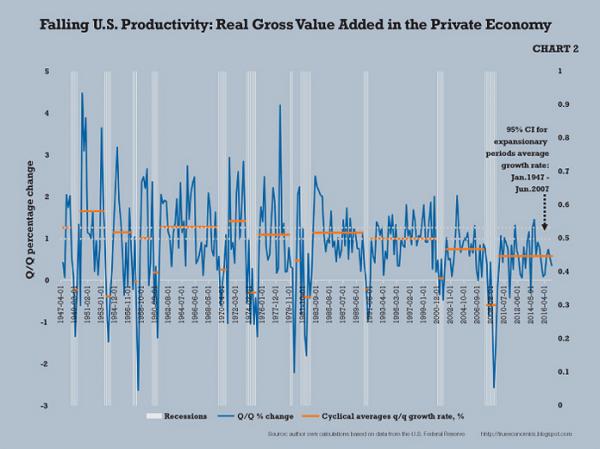
Greed
Last month, the Japanese government auctioned off some US$4 billion worth of new two-year bonds at a new record low yield of negative 0.149 percent. The country’s five-year debt is currently yielding minus 0.135 percent per annum, and its 10-year bonds are trading at -0.001 percent. Strange as it may sound, the safe haven status of Japanese bonds means that there is an ample demand among private investors, especially foreign buyers, for giving away free money to the Japanese government: the bid-to-cover ratio in the latest auction was at a hefty US$19.9 billion or 4.97 times the targeted volume. The average bid-to-cover ratio in the past 12 auctions was similar at 4.75 times. Japan’s status as the world’s most indebted advanced economy is not a deterrent to the foreign investors, banking primarily on the expectation that continued strengthening of the yen against the U.S. dollar, the U.K. pound sterling and, to a lesser extent, the euro, will stay on track into the foreseeable future. (See chart 1)
 In a way, the bet on Japanese bonds is the bet that the massive tsunami of monetary easing that hit the global economy since 2008 is not going to recede anytime soon, no matter what the central bankers say in their dovishly-hawkish or hawkishly-dovish public statements. And this expectation is not only contributing to the continued inflation of a massive asset bubble, but also widens the financial sustainability gap within the insurance and pensions sectors. The stage has been set, cleaned and lit for the next global financial crisis.
In a way, the bet on Japanese bonds is the bet that the massive tsunami of monetary easing that hit the global economy since 2008 is not going to recede anytime soon, no matter what the central bankers say in their dovishly-hawkish or hawkishly-dovish public statements. And this expectation is not only contributing to the continued inflation of a massive asset bubble, but also widens the financial sustainability gap within the insurance and pensions sectors. The stage has been set, cleaned and lit for the next global financial crisis.
Worldwide, current stock of government debt trading at negative yields is at or above the US$9 trillion mark, with more than two-thirds of this the debt of the highly leveraged advanced economies. Just under 85 percent of all government bonds outstanding and traded worldwide are carrying yields below the global inflation rate. In simple terms, fixed income investments can only stay in the positive real returns territory if speculative bets made by investors on the direction of the global exchange rates play out.
We are in a multidimensional and fully internationalized carry trade game, folks, which means there is a very serious and tangible risk pool sitting just below the surface across world’s largest insurance companies, pensions funds and banks, the so-called “mandated” undertakings. This pool is the deep uncertainty about the quality of their investment allocations. Regulatory requirements mandate that these financial intermediaries hold a large proportion of their investments in “safe” or “high quality” instruments, a class of assets that draws heavily on higher rated sovereign debt, primarily that of the advanced economies.
The first part of the problem is that with negative or ultra-low yields, this debt delivers poor income streams on the current portfolio. Earlier this year, Stanford’s Hoover Institution research showed that “in aggregate, the 564 state and local systems in the United States covered in this study reported $1.191 trillion in unfunded pension liabilities (net pension liabilities) under GASB 67 in FY 2014. This reflects total pension liabilities of $4.798 trillion and total pension assets (or fiduciary net position) of $3.607 trillion.” This accounts for roughly 97 percent of all public pension funds in the U.S. Taking into the account the pension funds’ penchant for manipulating (in their favor) the discount rates, the unfunded public sector pensions liabilities rise to $4.738 trillion. Key culprit: the U.S. pension funds require 7.5-8 percent average annual returns on their assets to break even on their future expected liabilities. In 2013-2016 they achieved an average return of below 3 percent. This year, things are looking even worse. Last year, Milliman research showed that on average, over 2012-2016, U.S. pension funds held 27-30 percent of their assets in cash (3-4 percent) and bonds (23-27 percent), generating total median returns over the same period of around 1.31 percent per annum.
Not surprisingly, over the recent years, traditionally conservative investment portfolios of the insurance companies and pensions funds have shifted dramatically toward higher risk and more exotic (or in simple parlance, more complex) assets. BlackRock Inc recently looked at the portfolio allocations, as disclosed in regulatory filings, of more than 500 insurance companies. The analysts found that their asset books – investments that sustain insurance companies’ solvency – can be expected to suffer an 11 percent drop in values, on average, in the case of another financial crisis. In other words, half of all the large insurance companies trading in the U.S. markets are currently carrying greater risks on their balance sheets than prior to 2007. Milliman 2016 report showed that among pension funds, share of assets allocated to private equity and real estate rose from 19 percent in 2012 to 24 percent in 2016.
The reason for this is that the insurance companies, just as the pension funds, re-insurers and other longer-term “mandated” investment vehicles have spent the last eight years loading up on highly risky assets, such as illiquid private equity, hedge funds and real estate. All in the name of chasing the yield: while mainstream low-risk assets-generated income (as opposed to capital gains) returned around zero percent per annum, higher risk assets were turning up double-digit yields through 2014 and high single digits since then. At the end of 2Q 2017, U.S. insurance companies’ holdings of private equity stood at the highest levels in history, and their exposures to direct real estate assets were almost at the levels comparable to 2007. Ditto for the pension funds. And, appetite for both of these high risk asset classes is still there.
The second reason to worry about the current assets mix in insurance and pension funds portfolios relates to monetary policy cycle timing. The prospect of serious monetary tightening is looming on the horizon in the U.S., U.K., Australia, Canada and the eurozone; meanwhile, the risk of the slower rate of bonds monetization in Japan is also quite real. This means that the capital values of the low-risk assets are unlikely to post significant capital gains going forward, which spells trouble for capital buffers and trading income for the mandated intermediaries.
Thirdly, the Central Banks continue to hold large volumes of top-rated debt. As of Aug. 1, 2017, the Fed, Bank of Japan and the ECB held combined US$13.8 trillion worth of assets, with both Bank of Japan (US$4.55 trillion) and the ECB (US$5.1 trillion) now exceeding the Fed holdings (US$4.3 trillion) for the third month in a row.
Debt maturity profiles are exacerbating the risks of contagion from the monetary policy tightening to insurance and pension funds balance sheets. In the case of the U.S., based on data from Pimco, the maturity cliff for the Federal Reserve holdings of the Treasury bonds, Agency debt and TIPS, as well as MBS is falling on 1Q 2018 – 3Q 2020. Per Bloomberg data, the maturity cliff for the U.S. insurers and pensions funds debt assets is closer to 2020-2022. If the Fed simply stops replacing maturing debt – the most likely scenario for unwinding its QE legacy – there will be little market support for prices of assets that dominate capital base of large financial institutions. Prices will fall, values of assets will decline, marking these to markets will trigger the need for new capital. The picture is similar in the U.K. and Canada, but the risks are even more pronounced in the euro area, where the QE started later (2Q 2015 as opposed to the U.S. 1Q 2013) and, as of today, involves more significant interventions in the sovereign bonds markets than at the peak of the Fed interventions.
How distorted the EU markets for sovereign debt have become? At the end of August, Cyprus – a country that suffered a structural banking crisis, requiring bail-in of depositors and complete restructuring of the banking sector in March 2013 – has joined the club of euro area sovereigns with negative yields on two-year government debt. All in, 18 EU member states have negative yields on their two-year paper. All, save Greece, have negative real yields.
The problem is monetary in nature. Just as the entire set of quantitative easing (QE) policies aimed to do, the long period of extremely low interest rates and aggressive asset purchasing programs have created an indirect tax on savers, including the net savings institutions, such as pensions funds and insurers. However, contrary to the QE architects’ other objectives, the policies failed to drive up general inflation, pushing costs (and values) of only financial assets and real estate. This delayed and extended the QE beyond anyone’s expectations and drove unprecedented bubbles in financial capital. Even after the immediate crisis rescinded, growth returned, unemployment fell and the household debt dramatically ticked up, the world’s largest Central Banks continue buying some US$200 billion worth of sovereign and corporate debt per month.
Much of this debt buying produced no meaningfully productive investment in infrastructure or public services, having gone primarily to cover systemic inefficiencies already evident in the state programs. The result, in addition to unprecedented bubbles in property and financial markets, is low productivity growth and anemic private investment. (See chart 2.) As recently warned by the Bank for International Settlements, the global debt pile has reached 325 percent of the world’s GDP, just as the labor and total factor productivity growth measures collapsed.
 The only two ways in which these financial and monetary excesses can be unwound involves pain.
The only two ways in which these financial and monetary excesses can be unwound involves pain.
The first path – currently favored by the status quo policy elites – is through another transfer of funds from the general population to the financial institutions that are holding the assets caught in the QE net. These transfers will likely start with tax increases, but will inevitably morph into another financial crisis and internal devaluation (inflation and currencies devaluations, coupled with a deep recession).
The alternative is also painful, but offers at least a ray of hope in the end: put a stop to debt accumulation through fiscal and tax reforms, reducing both government spending across the board (and, yes, in the U.S. case this involves cutting back on the coercive institutions and military, among other things) and flattening out personal income tax rates (to achieve tax savings in middle and upper-middle class cohorts, and to increase effective tax rates – via closure of loopholes – for highest earners). As a part of spending reforms, public investment and state pensions provisions should be shifted to private sector providers, while existent public sector pension funds should be forced to raise their members contributions to solvency-consistent levels.
Beyond this, we need serious rethink of the monetary policy institutions going forward. Historically, taxpayers and middle class and professionals have paid for both, the bailouts of the insolvent financial institutions and for the creation of conditions that lead to this insolvency. In other words, the real economy has consistently been charged with paying for utopian, unrealistic and state-subsidizing pricing of risks by the Central Banks. In the future, this pattern of the rounds upon rounds of financial repression policies must be broken.
Whether we like it or not, since the beginning of the Clinton economic bubble in the mid-1990s, the West has lived in a series of carry trade games that transferred real economic resources from the economy to the state. Today, we are broke. If we do not change our course, the next financial crisis will take out our insurers and pensions providers, and with them, the last remaining lifeline to future financial security.
Written by Constantin Gurdgiev and published by Cayman Financial Review ~ November 19, 2017.
Life, Liberty & All That Jazz is aired at 1:00 p.m. (Eastern Time) for TWO-HOURS, each Monday through Friday on The Micro Effect.

Kettle Moraine, Ltd.
P.O. Box 579
Litchfield Park, AZ 85340
1-623-327-1778
Email: [email protected]
 FAIR USE NOTICE: This site contains copyrighted material the use of which has not always been specifically authorized by the copyright owner. We are making such material available in our efforts to advance understanding of environmental, political, human rights, economic, democracy, scientific, and social justice issues, etc. We believe this constitutes a ‘fair use’ of any such copyrighted material as provided for in section 107 of the US Copyright Law. In accordance with Title 17 U. S. C. Section 107, the material on this site is distributed without profit to those who have expressed a prior interest in receiving the included information for research and educational purposes. For more information go to: http://www.law.cornell.edu/uscode/17/107.shtml
FAIR USE NOTICE: This site contains copyrighted material the use of which has not always been specifically authorized by the copyright owner. We are making such material available in our efforts to advance understanding of environmental, political, human rights, economic, democracy, scientific, and social justice issues, etc. We believe this constitutes a ‘fair use’ of any such copyrighted material as provided for in section 107 of the US Copyright Law. In accordance with Title 17 U. S. C. Section 107, the material on this site is distributed without profit to those who have expressed a prior interest in receiving the included information for research and educational purposes. For more information go to: http://www.law.cornell.edu/uscode/17/107.shtml








